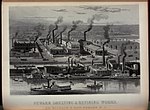Manhattan Transfer station
Demolished railway stations in the United StatesFormer Lehigh Valley Railroad stationsFormer Pennsylvania Railroad stationsFormer railway stations in New JerseyHarrison, New Jersey ... and 6 more
PATH stations in New JerseyRailway stations accessible only by railRailway stations closed in 1937Railway stations in Hudson County, New JerseyRailway stations in the United States opened in 1910Use mdy dates from April 2020

Manhattan Transfer was a passenger transfer station in Harrison, New Jersey, east of Newark, 8.8 miles (14.2 km) west of New York Penn Station on the Pennsylvania Railroad (PRR) main line, now Amtrak's Northeast Corridor. It operated from 1910 to 1937 and consisted of two 1,100 feet (340 m) car-floor-level platforms, one on each side of the PRR line. It was also served by the Hudson and Manhattan Railroad. There were no pedestrian entrances or exits to the station, as its sole purpose was for passengers to change trains.
Excerpt from the Wikipedia article Manhattan Transfer station (License: CC BY-SA 3.0, Authors, Images).Manhattan Transfer station
Essex Freeway,
Geographical coordinates (GPS) Address Nearby Places Show on map
Geographical coordinates (GPS)
| Latitude | Longitude |
|---|---|
| N 40.742 ° | E -74.144 ° |
Address
Essex Freeway
Essex Freeway
07029
New Jersey, United States
Open on Google Maps







